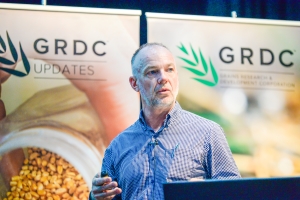Options for growers weighing up late season N application
Author: Toni Somes | Date: 11 Sep 2020

Good rainfall and wet soils across many parts of New South Wales this season have left grain growers evaluating their options when it comes to applying additional late nitrogen (N).
Grains Research and Development Corporation (GRDC) Grower Relations Manager – North, Graeme Sandral said there were simple guidelines that could help growers when making these decisions.
Mr Sandral said understanding how and when crop types laid down yield could help provide a clearer picture for evaluating late season N application.
“Two-row barley produces extra grain yield by increasing tiller numbers and at the later stages of barley development additional N is not likely to produce additional tillers,” he said.
“So late season N for barley should only be considered for N-deficient crops where good soil moisture conditions prevail to protect existing yield.
“In canola, the critical growth period is one to three weeks after the start of flowering so ideally late N on canola should be applied before this period to ensure there is time for adequate N uptake and yield response.
“In wheat, the critical growth period is three weeks before anthesis. Wheat, unlike two-row barley, will increase grain yield by increasing tiller numbers and grain numbers per tiller.
“Consequently, N application up to booting on wheat crops can increase grain yield (and protein) by increasing grain number per head.”
Mr Sandral said in summary, N application in early spring was best applied to wheat for profitable returns providing there was good soil moisture.
In many parts of NSW maximum wheat yield is produced at between 11 and 12 per cent protein which requires approximately 40 to 50kg of N/ha. A tonne of grain is produced from about 85 to 110 tillers/heads per metre squared and this range is generally influenced by differences in varietal choice, seasonal conditions and soil nutritional status just prior to anthesis and through to early grain fill.
Mr Sandral said that by counting the number of tillers per square metre, growers could estimate potential yield. For example, a wheat crop with 425 to 550 tillers m2 is estimated to produce approximately five tonnes per hectare and will need 200 to 250kg N/ha over the growing season.
“Growers can also compare the above method with the ‘water use’ rule of thumb that estimates potential yield,” he said.
“As a rule of thumb, 30 per cent of rainfall from December to March ends up as stored soil water available for crop production provided weeds are controlled and stubble is retained.
“Add this to estimated growing season rainfall and subtract 110mm for soil evaporation and you have an estimate of crop transpiration per hectare.”
Transpiration multiplied by 18 (kg of grain per mm of water transpired) gives an estimate of kg of grain per ha. For example, 75 mm of stored soil water plus 350 mm of growing season rainfall, less 110 mm, multiplied by 18 gives an estimated grain yield of 5670kg/ ha or 5.7t/ha.
Mr Sandral said in this hypothetical situation, the tiller counts estimated 5t/ha, while the estimated water limiting yield is 5.7t/ha. Where the water limited yield is the higher value it can be subtracted from the estimated tiller yield to produce the extra yield that requires nitrogen.
“In this simple example we take the yield difference of 0.7t/ha and multiply it by our soil N requirement per tonne (40 to 50 kg N/ha) to provide an estimated application rate range of 28 to 35kg N/ha,” Mr Sandral said.
“Using this calculation across wheat paddocks or zones within paddocks, growers can identify areas most likely to respond to late N and identify where the likely largest return on investment will occur.”
More detailed N budgets accounting for soil mineral N can be made in consultation with your agronomist.
Mr Sandral said other important considerations included:
- Avoid applying N to areas of surface water or to waterlogged soil, as its highly probable most of this N will be lost in denitrification processes.
- Ensure phosphorus levels (Colwell P values) in the paddock are adequate to maximise crop production.
Ensure other yield limitations are accounted for, such as soil sodicity.
Contact details
Contact
Toni Somes, GRDC Communications Manager – North
0436 622 645
toni.somes@grdc.com.au
Was this page helpful?
YOUR FEEDBACK
